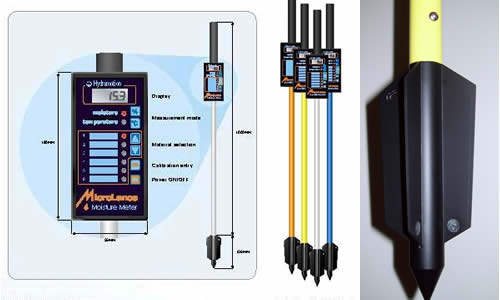Understanding the Various Types of Moisture Meters and Their Applications
Understanding the Various Types of Moisture Meters and Their Applications
Blog Article
Comprehending the Value of a Moisture Meter in Preventing Mold and Water Damages in your house
In the world of home maintenance, the presence of wetness can typically be a quiet yet powerful adversary, efficient in causing prevalent mold growth and dangerous water damage if left uncontrolled. Among the serene ambiance of a house, hidden moisture problems can make beneath the surface, posturing a hazard to both home and wellness. Geared up with the right devices and expertise, house owners can proactively fight these potential dangers. Comprehending the value of a dampness meter in this battle is not just an option but a strategic requirement.
Relevance of Moisture Discovery
Efficient moisture discovery approaches are crucial for guarding properties and stopping potential mold growth and water damage. Dampness can permeate into different building materials, bring about architectural problems and carcinogen. By using a wetness meter, building proprietors can proactively identify locations vulnerable to excess dampness, enabling prompt treatment and mitigation techniques.
Moisture meters provide precise readings of dampness levels in various products such as concrete, timber, and drywall. This information assists in determining locations of problem, even in covert or hard-to-reach locations. Early detection of moisture buildup makes it possible for timely fixings or changes to stop further damage.

Just How Moisture Meters Job
Wetness meters play a pivotal duty in the proactive recognition of excess moisture, aiding in the prevention of possible mold and mildew growth and water damages by giving precise analyses of moisture degrees in various structure products. Some advanced dampness meters integrate both pin and pinless modern technologies for thorough wetness discovery. Understanding exactly how moisture meters feature is necessary for timely and exact wetness degree evaluations, making it possible for effective precautionary measures versus mold and mildew and water damage.
Detecting Early Caution Signs
Upon preliminary inspection of a property, identifying refined indications of excess dampness becomes important in the early discovery of possible mold and mildew development and water damage. Some usual very early indication consist of mildewy odors, water discolorations on ceilings or walls, peeling paint or wallpaper, and warped or stained surfaces. Moldy odors frequently show the presence of mold and mildew or mildew, also if no noticeable indicators appear. Water spots can indicate leaks or seepage, while peeling off paint or wallpaper may be a result of wetness jeopardizing the bond of these products to the surface area. Distorted or blemished surfaces, such as distorting floorboards or stained drywall, are clear indicators of water damages. Additionally, an increase in allergy symptoms or respiratory system issues among occupants may suggest the visibility of mold and mildew because of excess wetness. By immediately recognizing and dealing with these very early indication, home owners can alleviate the risk of extensive mold and mildew growth and water damages in their properties.
Avoiding Mold And Mildew Growth
Recognizing early caution indicators of excess dampness within a property not only enables prompt discovery of potential mold growth and water damages however also offers as an aggressive procedure in stopping the proliferation of mold. To properly stop mold growth, it is important to attend to any type visit their website of sources of moisture promptly. This can consist of repairing leakages in home windows, roofings, or pipes, making sure proper ventilation in damp locations like bathrooms and kitchens, and making use of dehumidifiers in high-humidity rooms. Regularly examining and preserving the building's pipes, roofing, and seamless gutters can also help in avoiding water intrusion that could result in mold growth.
Keeping an eye on wetness degrees in areas prone to wetness, such as cellars and creep rooms, utilizing a dampness meter can likewise help in early detection of elevated moisture levels and prospective mold and mildew growth - Moisture Meter. By taking positive measures to avoid excess wetness and mold and mildew growth, house owners discover this can guard their property and interior air high quality.
Advantages of Normal Monitoring
Regular tracking of moisture levels in a property can play a vital role in maintaining a healthy and balanced indoor atmosphere and preventing potential mold and mildew and water damages. By routinely checking moisture levels, home owners can identify any kind of concerns without delay and take essential actions to protect against mold development and water damage. Among the vital advantages of regular monitoring is early discovery. By recognizing and resolving high wetness degrees early on, homeowners can interfere prior to mold and mildew has the chance to spread out and develop. This positive method can conserve both money and time in the long run by protecting against comprehensive mold and mildew remediation and repair service costs.
Additionally, routine tracking permits homeowners to track patterns and trends in moisture degrees gradually. By developing a baseline and monitoring adjustments, people can determine any kind of locations of issue or possible vulnerabilities in the residential property's structure. This data-driven strategy enables targeted interventions and upkeep initiatives to resolve underlying concerns prior to they escalate right into more substantial issues. Inevitably, the constant tracking of wetness degrees encourages property owners to secure their residential property, protect their health, and maintain the stability of their indoor setting.

Verdict

By using a dampness meter, residential or commercial property proprietors can proactively recognize areas susceptible to excess dampness, allowing for prompt treatment and mitigation approaches.

Keeping track of wetness degrees in locations vulnerable to dampness, such as basements and crawl rooms, utilizing a dampness meter can also assist in very early detection of elevated dampness levels and prospective mold and mildew growth. (Moisture Meter)
Report this page